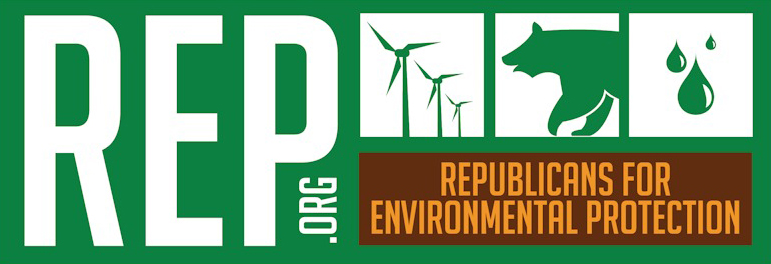
REP’S HISTORY, PART 1
1995: THE YEAR IT ALL BEGAN

Aurie Kryzuda
This website and the organization that previously stood behind it were part of a national grassroots movement that began in 1995.
In April of that year, three Republican women, Aurie Kryzuda (CA), Martha Marks (IL), and Kim O’Keefe (FL), met for the first time at an environmental conference in Maryland. As they got to know one another, they decided there was a need for a GOP environmental organization and set out to make it happen. Thanks to the energy they brought to their new project, by autumn the name Republicans for Environmental Protection already had burst into the American consciousness.
Letters to the editors of local newspapers, like these, began popping up around the country:
- Assault on environmental laws disturbs some in GOP, by Dr. Bob Stoll, an early REP member in Florida, in the St. Petersburg Times in September 1995
- GOP turning green, which Martha Marks placed in the Chicago Tribune in November 1995.
Through individual word-of-mouth efforts like those, REP’s visibility and membership grew quickly across the country. Journalists began writing clever “man bites dog” stories. People of all parties cheered the notion of a genuine environmental organization for Republican voters. Especially since that organization and its members announced their intention to improve GOP policies. And aimed to persuade GOP elected officials to be better stewards. And began advocating for the GOP to fully protect America’s air, water, climate, public lands, and wildlife.
1996-2006: AN EXCITING DECADE OF GROWTH AND POLITICAL ENGAGEMENT
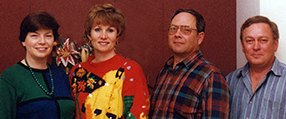
Four members of the Steering Committee — Martha Marks, Kim O’Keefe, Sam Booher, and Vince Williams — at their first meeting.
1996: Getting acquainted, laying the foundation
As 1995 ended, REP consisted of its three “founding mothers” — Aurie, Kim, and Martha — and a random assortment of “interested others” around the country. Although there had been some word-of-mouth recommendations, most of the newcomers had read about this upstart new Republican environmental group in their local newspapers or in the publications of other environmental organizations. Despite all those press reports, there was no real there there.

New Hampshire State Senator Rick Russman (l) and Jameson French (r) with Martha Marks days before the GOP primary in 1996
So, early in 1996, Aurie, Kim, and Martha invited the most enthusiastic new members to join them in Jacksonville to help write bylaws for the soon-to-be organization.
The Steering Committee that gathered first in Florida included Sam Booher (GA) and Vince Williams (GA). Not long after, they and two others — Jim DiPeso (WA) and Merideth Mueller (NJ) — formed the original Board of Directors, which then incorporated REP in Illinois. The final legal step came the following year, when REP received its all-important 501(c)(4) non-profit status from the IRS.
Jim would go on to be one of REP’s most prolific advocates, with hundreds of speeches, letters to the editor, and op-eds to his credit. But on April 25, 1996, he published the very first of those, GOP leaders should protect the environment, in the Valley Daily News, Kent, Washington.
Also early in 1996, in the dead of winter right before the New Hampshire primary, Martha made her first REP-promoting trip to any state. The most important people she met there were two well-known Republican conservationists, State Senator Rick Russman and Jameson French, whose many credentials included being one of the first to embrace the concept of forest certification and serving as Chairman of the Society for the Protection of New Hampshire Forests. As a result of that meeting, both men became REP members.
The publication of an op-ed, Eco-Gluttons? Not these Republicans! in the October 1, 1996 issue of the Christian Science Monitor was REP’s first true journalistic accomplishment. It was credited jointly to Martha and Jim as directors… although Martha always made sure everybody knew that Jim was the actual author.
So, in its first full year — before it had a website or a newsletter — REP won some useful bragging rights. And even, now after all these years, that op-ed is worth bragging about, because it’s pretty darn good… and still timely!
1997-1998: Having fun, making progress

Four local members and four directors — Merideth (in center), Jim (back, right), Sam (front, right), and Martha (left) — attend REP’s first annual meeting at Illinois Beach State Park in 1997.
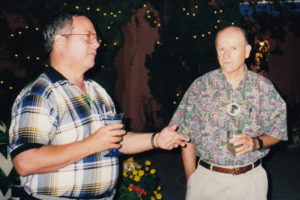
Board members Sam Booher and Chester Sansbury get acquainted in 1998, at REP’s second annual meeting in Arizona. (photo © Martha Marks)
By 1997, REP had a logo and its first promotional brochure. It bought the URL rep.org and built a primitive website on it, even as it began printing a quarterly newsletter called The Green Elephant.
Since the directors lived all over the country, they could not meet regularly in person. Conference calls were too expensive at that time, and communication tools like Zoom did not yet exist. So, using the newest technology of that decade, they found a way to conduct their official meetings via AOL chat rooms. The board did hold what would come to be known as its first annual meeting at the lodge at Illinois Beach State Park, on the shore of Lake Michigan. The photo shows four founding board members — Merideth Mueller (NJ), Jim DiPeso (WA), Sam Booher (GA), and Martha Marks (IL) — along with four early members from northern Illinois.
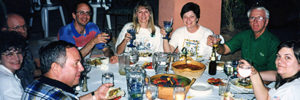
A happy group toasts to REP over dinner near Tucson at its second annual meeting in 1998. Counter-clockwise from left: Sam and Laurie Booher (GA), Chester Sansbury (SC), Jim DiPeso (WA), Kathy Roediger (AZ), Martha Marks (IL), Bob Eidsmoe (AZ), and Tamilyn Sanderson (MI).
In 1998, fourteen members gathered at the picturesque Rex Ranch south of Tucson for REP’s second annual meeting. Two new directors — Kathy Roediger (AZ) and Chester Sansbury (SC) — had been chosen in the first board election (“of REP members, by REP members, for REP members”). As the photos show, it was another enjoyable get-to-know-you event… even if participants did have to learn to put their shoes on a high shelf before they went to sleep to prevent tarantulas from taking up residence in them overnight.
To illustrate how REP initially framed its message to members and others, here are the main articles from The Green Elephant in its first two years:
- Our Grand Old Party: Painted into a Corner on the Environment (spring 1997)
- REP joins The Green Scissors Coalition! (spring 1997)
- In case you didn’t know (spring 1997)
- Republicans and the Environment — a speech by Theodore Roosevelt IV (summer 1997)
- Conservative Principles and the Environment — John R. E. Bliese, Ph.D. (fall 1997)
- Thoughts of a Conservative Environmentalist, Part 1 — Gordon Durnil (winter 1997)
- Proud to Praise ‘Em! (winter 1997)
- Thoughts of a Conservative Environmentalist, Part 2 — Gordon Durnil (spring 1998)
- Proud to Praise ‘Em! (spring 1998)
- GOP Greens and Greenscammers (summer 1998)
- Whither the GOP? (fall 1998-winter 1999)

Pennsylvania Chapter President Sandy Moser created REP’s first state chapter newsletter, The Green Elephant’s Gazette. Others would follow soon after.
1999-2000: Branching out, setting big goals

Five REP directors in the mountains of New Mexico in 2000. From left: Tony Cobb (MD), Martha Marks (IL), Phil Pryde (CA), Aurie Kryzuda (CA), and Jim DiPeso (WA). Jim had just received REP’s first-ever Green Elephant Award.
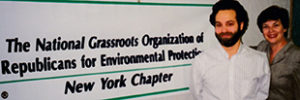
Paul Charney, president of REP’s New York Chapter, with Martha Marks.
In 1999 and 2000, at its third and fourth annual meetings, the board and different sets of members gathered in Solomons Island, Maryland, and Jemez Springs, New Mexico. That established a pattern of holding events in different places around the country. Increasingly, they were held in areas with clusters of enthusiastic members. Over the years that followed, REP took its Green GOP energy to Myrtle Beach, San Diego, Chicago, Albuquerque, Philadelphia, Golden (CO), Orlando, and San Antonio.
In addition to offering appealing venues, those “mobile meetings” had the extra benefit of allowing members from all over to get to know one another, interact with the board and attend its annual meetings, hear knowledgeable guest speakers (Republicans and others), and learn how to become more actively engaged in their own communities and states. Reporters around the country wrote “local interest” stories. Almost everywhere, non-members and even a few Republican officials from the area attended to see what the excitement was all about.
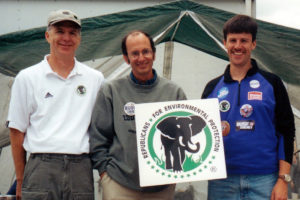
Tom MacLean, Jim DiPeso, and Bruce Fisher, Washington Chapter leaders, table for REP.

Early leaders of the Michigan Chapter, Greg Ostrander, Tamilyn Sanderson, and Don Perkins table for REP, with Martha Marks.
Three new directors were elected to the board in 2000: Robin Tyner (IL), Tony Cobb (MD) and Dr. Phil Pryde (CA). All three would go on to have long and productive relationships with both REP and its affiliated foundation, which was established in 1999.
REP Directors Chester Sansbury, Jim DiPeso, and Martha Marks were the incorporators of that REP-affiliated 501(c)(3) non-profit, which experimented with two names before finding its durable niche as Conservatives for Responsible Stewardship.
During this same time period, REP members began forming official state chapters. Their goal was two-fold: to take pro-environmental position on state issues and to grow state and local membership so that they could become a positive influence on their own GOP elected officials and candidates for office.
Ultimately, twelve chapters were chartered: California, Colorado, Florida, Hawaii, Illinois, Michigan, New Mexico, New York, Oregon, Pennsylvania, Texas, and Washington State. Soon all were holding their own events. Some also hosted national REP’s annual conferences.
The Pennsylvania Chapter, under the leadership of Chapter President Sandy Moser, began producing it’s own newsletter, which they called The Green Elephant’s Gazette. State Representative and REP member David J. Steil wrote Is sprawl a Republican issue? for the fall 1999 Gazette.
Around this same time, Phil Pryde, Ph.D.— a leader of both national REP and its emerging California Chapter — wrote REP’s first two position papers, on oceans and wetlands. He also penned an introductory essay about REP that he made available to other environmental organizations, many of whom reprinted it, thereby helping to spread the word and grow REP’s membership. We’ve updated that article a wee bit and reposted it here: Can elephants really hug trees? Feel free to share it with others if you like.

Representatives Sherwood Boehlert and Sue Kelly (both R, NY) at REP’s 1999 “Green GOP Heroes” reception in Washington, DC. (photo © Martha Marks)
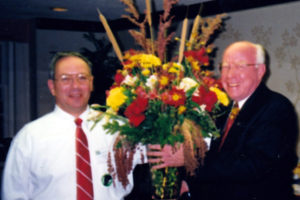
Sam Booher with Congressman Vern Ehlers. Since REP leaders couldn’t take the gorgeous flowers on their flights home, they offered them to Rep. Ehlers, who had lingered to the end of the reception. He happily accepted and carried them back to his Capitol Hill office. (photo © Martha Marks)
1999 was notable, too, as the year when REP hosted its first two “Big Events.”
The first Big Event was a springtime reception at the Capitol Hill Club in Washington, D.C. The honored guests were a dozen “Green Republican” Members of Congress. At least as many REP members traveled there to meet them and thank them. All of the VIP guests later became members of REP’s Honorary Board.
The second Big Event came in the fall. Theodore Roosevelt IV flew from New York to Orlando to join other distinguished GOP conservationists and environmentalists from Florida and around the country at REP’s first-ever Republican Environmental Summit, which Martha organized and moderated.

Sam Booher (l), John Whitescarver (c), and Jim Ridenour on the boat ride to Pelican Island (photo © Martha Marks)
Attendees included Jim Ridenour, former director of the National Park Service under President G. H. W. Bush; Allison DeFoor, known as the “Everglades Czar” under Governor Jeb Bush; and John Whitescarver, founder of the National Stormwater Center, an organization dedicated to promoting and advocating compliance with the Clean Water Act.
Ted Roosevelt also addressed the group at Saturday night’s dinner: The Legacy of Pelican Island.

Theodore Roosevelt IV delivers his speech, “The Legacy of Pelican Island,” to REP’s dinner guests in Orlando. (photo © Martha Marks)
It was also a fine weekend for reasons apart from the discussions, dinner, and speech.
First, while in Orlando, the group visited a rehabilitation center for injured manatees, where several participants took turns feeding the winsome sea mammals.
Second, Ted and most of the others took a chartered bus to the Atlantic Coast, where they enjoyed a picnic lunch in a park before boarding a boat for a slow cruise around Pelican Island National Wildlife Refuge. This small sliver of land was America’s very first national wildlife refuge, personally established by President Theodore Roosevelt in 1903.

Ted Roosevelt feeds a manatee as Allison DeFoor looks on (photo © Martha Marks)
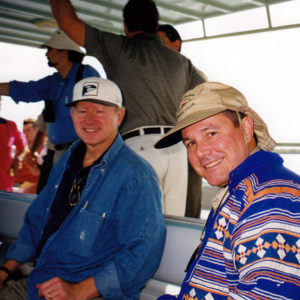
Bernie Marks (l) with “Everglades Czar” Allison DeFoor on the boat ride to Pelican Island (photo © Martha Marks)
Third, during the picnic on the coast, reenactors in period costumes, including a dynamic TR impersonator, entertained with songs and jokes of the TR era.
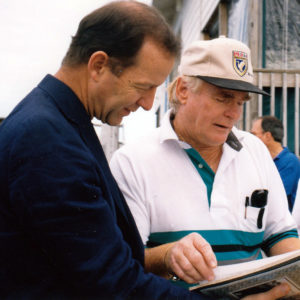
Ted Roosevelt admires a family photo album brought to the event by the grandson of the first manager of Pelican Island National Wildlife Refuge. (photo © Martha Marks)
Fourth, the grandson of Paul Kroegel—the original manager at Pelican Island and the first national wildlife refuge manager in America’s history—joined them for a nostalgic reunion with the great-grandson of the man who had hired his grandfather to protect the endangered birds on the island.

A large flock of white pelicans on Pelican Island National Wildlife Refuge (photo © Martha Marks)
Fifth, they all got closeup, leisurely views of flocks of white pelicans on the island refuge, which was not open to visitors on foot.
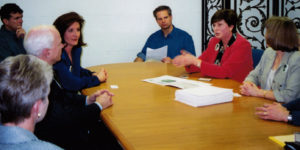
REP board members Aurie Kryzuda (l), Martha Marks (c), and Kathy Roediger (r) meet with John McCain, his wife Cindy, and two of his staff in January 2000. (photo © Bernard Marks)
2000: Getting political (as REP was born to be)
In January of the election year 2000, Republicans for Environmental Protection began endorsing candidates for office in advance of the GOP primaries. The first came shortly before three board members — Aurie Kryzuda, Martha Marks, and Kathy Roediger — met in Phoenix with Senator John McCain, his wife Cindy, and his staff. REP’s board had decided to endorse him for president and wanted to inform him of that fact in person. Read Martha’s column from The Green Elephant, announcing the McCain endorsement to REP members.
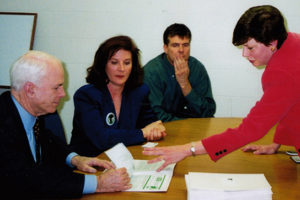
Senator McCain receives a copy of The Green Elephant containing his endorsement in January 2000. (photo © Bernard Marks)
Something remarkable happened at that meeting. The first thing McCain said when he entered the room was, “What do I tell ’em about climate change? Everywhere I go, people are asking me about climate change, and I don’t know how to answer.” The REP leaders took at each other and nodded. “Senator, we’ll get you a policy paper on that.” And they did. Within a week, Jim DiPeso, who wasn’t even at that meeting, prepared an excellent white paper that gave the McCain campaign the requested information: Policy Paper on Global Climate Change. (PDF download)

Aurie, Martha, and Kathy pose with Senator McCain in January 2000. (photo © Bernard Marks)
Soon after, the REP leaders began to hear McCain giving speeches and talking to the media about climate change, reflecting REP’s ideas of how to combat it. (Later on that year, McCain introduced in the Senate the first-ever legislation addressing climate change. It seemed for a time that climate change might actually become an important issue for Republican elected officials to take on.)

REP co-founder Aurie Kryzuda (r) and other California members at a McCain rally in San Diego in 2000.
Then in April, in New York City, Martha held an endorsement press conference with Senator McCain. Later, she rode with him, his wife, his daughter, and his staff on the “Straight Talk Express,” his campaign bus, to an enormous rally on Wall Street. She still says that was one of the most exciting and unforgettable days of her life.
Later in 2000, REP honored Senator McCain with a reception right before the Massachusetts Republican Party’s Lincoln Dinner in Boston, where he was to be the keynote speaker. The mood was an mix of sweet, sad, and tender, not only because someone else — whom REP had not endorsed — was the GOP nominee for president, but also because doctors had just removed a tumor from McCain’s face.

REP President Martha Marks rides with Senator John McCain on his “Straight Talk Express” bus in NYC in the spring of 2000.

Senator John McCain speaks at a REP reception in his honor in June 2000, with Martha at his side.

Board Member Chester Sansbury tables for REP in Columbia, South Carolina on Earth Day 2000
During the 2000 primary season, REP also backed Mark Kirk of Illinois for the US House. Kirk won that seat and later became a U.S. senator.
Once again in 2000, REP held its second internal election per its Bylaws, allowing members to run for the board or choose directors from among their own ranks. In all, REP held those member-run elections every two years between 1998 and 2008.
And in 2000, they also began inviting current and former “Green GOP” Republican elected and appointed officials to join REP’s new Honorary Board. Within a couple of years, there were more than thirty: senators, representatives, governors, EPA administrators, Interior secretaries, and so on. It was a perfect way to show mutual appreciation and support… both for them and from them.
And of course they continued publishing great feature articles in The Green Elephant, like this: “Environmentalism and Patriotism” by REP Director Philip R. Pryde, Ph.D.
And individual REP members continued promoting REP in their communities and writing excellent op-eds for their local newspapers, like this one that REP member Joan King published in the Gainesville (GA) Times on October 31, 2000: Principle wins out on this point. To this day, what Joan wrote about REP decades ago still brings tears to our eyes.
xx
CLICK HERE TO CONTINUE READING REP’S HISTORY, PART 2: 2001-2005
Also in this section:
- REP’s history: PART 1: 1995-2000 | PART 2: 2001-2005 | PART 3: 2006-
Return to ALL ABOUT REP
Return to top of page
xx
Photo at top: Sunset Crater Volcano National Monument, with its reddish cinder cone and thousand-year-old lava flow, is one of the many natural wonders that President Herbert Hoover protected during his single term in office, using President Theodore Roosevelt’s Antiquities Act of 1906. Click here to visit the Antiquities Act page on the website of The Green Elephant Coalition, which is loosely affiliated with REP. (photo © Martha Marks)
